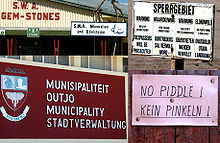
Windhoek is the capital and largest city of Namibia. It is located in central Namibia in the Khomas Highland plateau area, at around 1,700 m (5,600 ft) above sea level, almost exactly at the country's geographical centre. The population of Windhoek, which was 486,169 in 2023, is constantly growing due to a continued migration from other regions in Namibia.

Lüderitz is a town in the ǁKaras Region of southern Namibia. It lies on one of the least hospitable coasts in Africa. It is a port developed around Robert Harbour and Shark Island.

Karibib is a town in the Erongo Region of western Namibia. It has 3,800 inhabitants and owns 97 square kilometres (37 sq mi) of town land. Karibib is the district capital of the Karibib electoral constituency. It is situated on the Khan River, halfway between Windhoek and Swakopmund on the B2, the main road between Walvis Bay and Johannesburg. The town is known for its aragonite marble quarries and the Navachab Gold Mine.
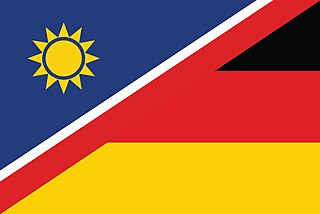
German Namibians are a community of people descended from ethnic German colonists who settled in present-day Namibia. In 1883, the German trader Adolf Lüderitz bought what would become the southern coast of Namibia from Josef Frederiks II, a chief of the local Oorlam people, and founded the city of Lüderitz. The German government, eager to gain overseas possessions, annexed the territory soon after, proclaiming it German South West Africa. Small numbers of Germans subsequently immigrated there, many coming as soldiers, traders, diamond miners, or colonial officials. In 1915, during the course of World War I, Germany lost its colonial possessions, including South West Africa ; after the war, the former German colony was administered as a South African mandate. The German settlers were allowed to remain and, until independence in 1990, German remained an official language of the territory alongside Afrikaans and English.
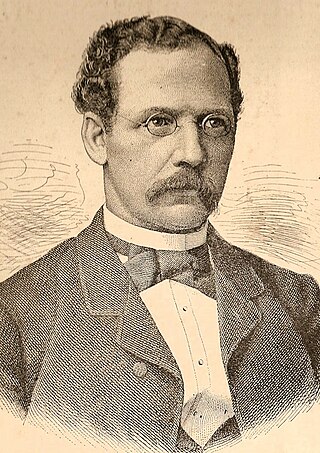
Franz Adolf Eduard Lüderitz was a German merchant and the founder of German South West Africa, Imperial Germany's first colony. The coastal town of Lüderitz, located in the ǁKaras Region of southern Namibia, is named after him.
The Deutsche Höhere Privatschule (DHPS) is a private school in Namibia and a German International School Abroad. Situated in the capital Windhoek, The DHPS also offers boarding school facilities, a kindergarten and pre-school and primary and secondary grades from grade 1 to 12. Various sporting facilities are part of the spacious campus in the centre of town, e.g. swimming pool, hostel, basketball courts, soccer fields, beach volleyball field and roller hockey rink. Scholars have the option of leaving with the internationally recognized Cambridge Certificate in grade 12, or doing the Deutsche Internationale Abiturprüfung, also in grade 12. Both school leaving certificates exempt them for universities and tertiary institutions in Germany, Southern Africa and worldwide.

TransNamib Holdings Limited, commonly referred to as TransNamib, is a state-owned railway company in Namibia. Organised as a holding company, it provides both rail and road freight services, as well as passenger rail services. Its headquarters are in the country’s capital Windhoek.
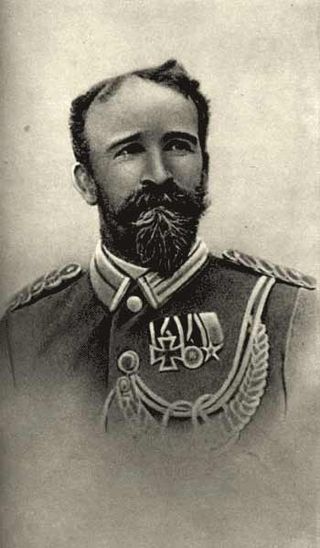
Curt Karl Bruno von François was a German geographer, cartographer, Schutztruppe officer and commissioner of the imperial colonial army of the German Empire, particularly in German South West Africa where he was responsible on behalf of Kaiser for the foundation of the city of Windhoek on 18 October 1890 and the harbor of Swakopmund on 4 August 1892.
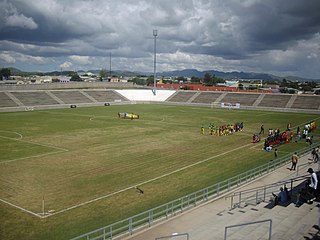
The principal sports in Namibia are football, rugby union, cricket, golf and fishing. Boxing and athletics are also popular. The home stadium for all national teams is Independence Stadium in Windhoek, while Sam Nujoma Stadium in Katutura is also occasionally used.
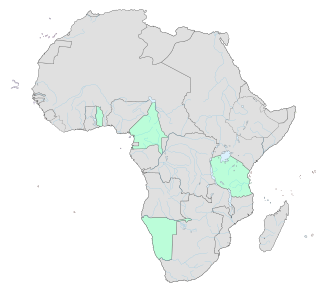
Germany colonized Africa during two distinct periods. In the 1680s, the Margraviate of Brandenburg, then leading the broader realm of Brandenburg-Prussia, pursued limited imperial efforts in West Africa. The Brandenburg African Company was chartered in 1682 and established two small settlements on the Gold Coast of what is today Ghana. Five years later, a treaty with the king of Arguin in Mauritania established a protectorate over that island, and Brandenburg occupied an abandoned fort originally constructed there by Portugal. Brandenburg — after 1701, the Kingdom of Prussia — pursued these colonial efforts until 1721, when Arguin was captured by the French and the Gold Coast settlements were sold to the Dutch Republic.
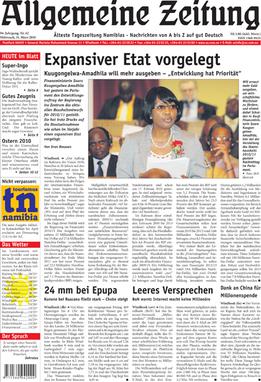
The Allgemeine Zeitung founded in 1916, is the oldest daily newspaper in Namibia and the only German-language daily in Africa to survive World War I.

Lüderitz railway station is a railway station serving the town of Lüderitz in Namibia. It was erected in 1904.

German South West Africa was a colony of the German Empire from 1884 until 1915, though Germany did not officially recognise its loss of this territory until the 1919 Treaty of Versailles.

German South West Africa was a German colony in Africa, established in 1884 with the protection of the area around Lüderitz and abandoned during World War I, when the area was taken over by the British.

Parliamentary elections were held in South West Africa on 31 October 1934. The whites-only election saw a victory for the United National South West Party, which won eight of the twelve elected seats in the Legislative Assembly.

Namib High School is a secondary government school in Swakopmund, Namibia. It has 640 learners and 28 teachers. Founded as Städtische Realschule mit Grundschule during the colonial time of German South-West Africa in 1913 it is one of the oldest schools in Namibia.
GDR-Children of Namibia is a colloquial term denoting black Namibian children that were raised in East Germany, also known as the German Democratic Republic (GDR). During the South African Border War, the children of hundreds of Namibian refugees and political exiles were resettled and educated in the GDR from 1979 onwards. They were repatriated upon German reunification and their native country's formal independence from South Africa in 1990.

Hitradio Namibia is the first and only German language private radio station in Namibia. The station went on air on August 1, 2012. Owners were the German Namibians Wilfried Hähner and Sybille Rothkegel, and since October 2020 Sybille Moldzio, Björn Eichhoff and Kai-Uwe Schonecke.
Mass media in Namibia includes radio, television, and online and print formats.
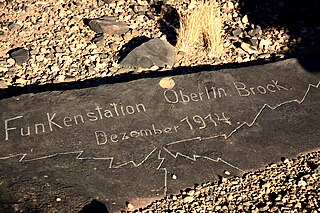
A series of radio stations in German South West Africa enabled the Germans to communicate between their colony, German South West Africa, and their motherland, the German Empire. They also used radio to communicate within the German South West Africa territory and with German boats at sea. The stations utilized spark-gap transmitters.



